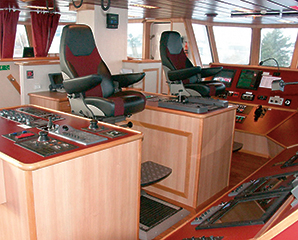 "Who would have guessed we'd be actively engaged in rapid manufacturing so soon after investing in a new rapid prototyping tool?", Andy Smith, SA
"Who would have guessed we'd be actively engaged in rapid manufacturing so soon after investing in a new rapid prototyping tool?", Andy Smith, SA
Charting a new course for manufacturing
Designed for an off-shore oil-drilling rig, this drill-operator control chair was prototyped with the help of a Fortus 3D Printer. Then 25 of its components were manufactured by the Fortus 3D Printer.
SAP (Sørlandets Aluminiumprodukter) in Kristiansand, Norway, designs and manufactures products for demanding marine environments. It produces helmsman chairs, table columns and other equipment for the marine industry as well as custom products for the offshore industry. Tight deadlines and high expectations are daily challenges faced by the team at SAP, and it needed a solution to speed up design without compromising accuracy.
Following its success with outsourced prototyping work, SAP justified having its own in-house 3D printer. Product development manager Harald Jansen says they needed to prove out more than just aesthetics. "Mocking up a beautiful but fragile product is one thing," he says, "but we needed to determine more than just whether it looked nice. We needed to test fit and functionality as well. The Fortus machine offered capacity, a variety of performance materials, quality finish, and virtually no post processing. It was clearly the solution for us."
Beyond Prototyping
The technology has changed the way SAP works. Its first project, based entirely on prototyping, was an iterative feasibility study for a new table column with adjustable, telescopic height. Over a two-week period, designers produced a dozen different models, with varying designs, in both polycarbonate and ABS. "The prototypes gave us the clear answers we were looking for," says Jansen. "This was the kind of product development we wanted, and yet we had barely begun to see its potential."
Prototyping turned out to be the tip of the iceberg for SAP, as it quickly learned how durable the parts could be. Andy Smith, SAP's industrial designer, elaborates on the company's transition from prototyping to manufacturing. "We were struggling to meet a deadline on a series of particularly complex driller operator chairs for the offshore industry. Most of the design was completely new, yet it had to be out of the door in a matter of days." As a shortcut, the team used the Fortus 3D Printer to pump out small, intricate parts for testing. Not only were they strong and durable, the shiny black parts looked so good on the chairs that the team knew they could be more than just prototypes.
"There was absolutely no reason why they couldn't be production parts," says Smith. "The FDM parts simplified the designs for complex moving and interlocking mechanisms, they stood up to all our testing, and the company who ordered the chairs loved the look." Equally important, the customer has satisfactorily integrated the product into drilling solutions in service in the North Sea.
SAP now produces hundreds of production parts – many of them unusual looking designs that would otherwise require injection molding – that are generally ready the next day. "Who would have guessed we'd be actively engaged in direct digital manufacturing on a daily basis so soon after investing in a new prototyping tool?" says Smith.
Jansen summarizes, "We knew the [Fortus] machine would cut development time; we knew it would save money; we knew it would be exciting. But we had no idea that our original plan for the prototyping machine would be turned on its head. We had anticipated that in terms of machine use, prototyping would outweigh production by a very large margin, yet today around 70 percent of the parts are for production. Compressing the design cycle like this has been nothing short of revolutionary for us."
www.stratasys.com





























































































